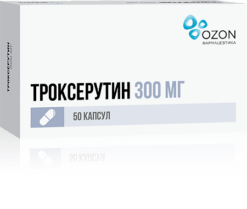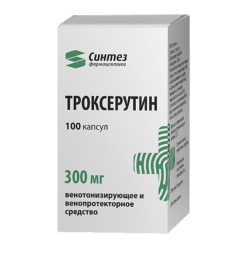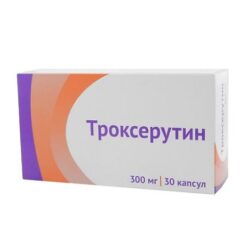No products in the cart.
Troxerutin Velpharm, capsules 300 mg 50 pcs
€13.85 €12.01
Description
Pharmacotherapeutic group: venotonic and venoprotective agent.
TAC code: C05CA04.
Pharmacological properties
Pharmacodynamics
. Semisynthetic bioflavonoid (rutin derivative) of benzopyran class; it possesses P-vitamin activity, has venotinizing, angioprotective, anti-inflammatory and anti-edema effect, decreases capillary permeability and fragility.
His pharmacodynamic properties are associated with the participation of bioflavonoids of troxerutin in redox processes and hyaluronidase inhibition. Inhibiting hyaluronidase, troxerutin stabilizes hyaluronic acid of cell membranes and reduces their permeability. It has antioxidant activity, as a result of which it prevents oxidation of ascorbic acid, adrenaline and lipids. In addition, it reduces the permeability and fragility of capillaries, prevents damage to the basal membrane of endothelial cells when it is exposed to various factors. Troxerutin increases the density of the vascular wall, reduces the exudation of the liquid part of the plasma and diapedesis of the blood cells. Reduces exudative inflammation in the vascular wall by reducing platelet adhesion to its surface. Inhibits aggregation and increases the degree of red blood cell deformation.
The use of troxerutin is possible both in the initial and in the late stages of treatment of chronic venous insufficiency, it is possible to use as one of the components of complex treatment. Troxerutin reduces swelling and heaviness in the legs, decreases the intensity of pain and cramps and improves tissue trophism.
Troxerutin relieves symptoms associated with hemorrhoids (pain, exudation, itching, bleeding).
According to its influence on the permeability and resistance of capillary walls, troxerutin helps to slow down the progression of diabetic retinopathy.
The influence of troxerutin on the rheological properties of the blood helps to prevent the development of retinal vascular microthrombosis.
Pharmacokinetics
Troxerutin is quickly absorbed when the drug is taken orally. Maximum plasma concentration (Cmax) of troxerutin is reached on average 1.75 ± 0.46 hours after oral administration. Absorption is approximately 10-15%. Bioavailability of the drug increases with increasing dose. The half-life (T1/2) is 6.77 ± 2.37 hours. Therapeutic concentration of the drug in blood plasma is maintained for 8 hours. In 30 hours after troxerutin administration a second maximum of the drug concentration in plasma is observed due to enterohepatic recirculation. It is partially metabolized in the liver to form glucuronide and trihydroethylquercitin. It is excreted mainly through intestine (up to 65-70%), a smaller part (up to 25%) of the drug is excreted unchanged by the kidneys.
Indications
Indications
– varicose veins;
– chronic venous insufficiency with such manifestations as heaviness in the legs, trophic skin lesions (dermatitis, trophic ulcers);
– superficial thrombophlebitis, periphlebitis;
– haemorrhoids;
– postthrombotic syndrome;
– post-traumatic edema, hematoma;
– prevention of complications after sclerotherapy and/or removal of varicose veins of the lower extremities;
– as part of complex treatment of retinopathy in patients with diabetes mellitus, arterial hypertension and atherosclerosis.
Pharmacological effect
Pharmacological effect
Pharmacotherapeutic group: venotonic and venoprotective agent.
ATX code: C05CA04.
Pharmacological properties
Pharmacodynamics
A semi-synthetic bioflavonoid (rutin derivative) of the benzopyran class, has P-vitamin activity, has venotonic, angioprotective, anti-inflammatory and decongestant effects, reduces capillary permeability and fragility.
Its pharmacodynamic properties are associated with the participation of the bioflavonoids troxerutin in redox processes and inhibition of hyaluronidase. By inhibiting hyaluronidase, troxerutin stabilizes hyaluronic acid in cell membranes and reduces their permeability. It has antioxidant activity, which prevents the oxidation of ascorbic acid, adrenaline and lipids. In addition, it reduces the permeability and fragility of capillaries, prevents damage to the basement membrane of endothelial cells when exposed to various factors. Troxerutin increases the density of the vascular wall, reduces the exudation of the liquid part of the plasma and the diapedesis of blood cells. Reduces exudative inflammation in the vascular wall, reducing platelet adhesion to its surface. Inhibits aggregation and increases the degree of deformation of red blood cells.
The use of troxerutin is possible both in the initial and late stages of treatment of chronic venous insufficiency; it can be used as one of the components of complex treatment. Troxerutin reduces swelling and a feeling of heaviness in the legs, reduces the intensity of pain and cramps, and improves tissue trophism.
Troxerutin relieves symptoms associated with hemorrhoids (pain, exudation, itching, bleeding).
Due to its effect on the permeability and resistance of capillary walls, troxerutin helps slow the progression of diabetic retinopathy.
The effect of troxerutin on the rheological properties of blood helps prevent the development of retinal vascular microthrombosis.
Pharmacokinetics
Troxerutin is rapidly absorbed when the drug is taken orally. The maximum concentration of troxerutin in the blood plasma (Cmax) is established on average 1.75 ± 0.46 hours after oral administration. Absorption is approximately 10-15%. The bioavailability of the drug increases with increasing dose. The half-life (T1/2) is 6.77 ± 2.37 hours. The therapeutic concentration of the drug in the blood plasma is maintained for
8 o’clock. 30 hours after taking troxerutin, a second maximum concentration of the drug in the blood plasma is observed, due to enterohepatic recirculation. Partially metabolized in the liver to form glucuronide and trihydroethylquercetin. It is excreted mainly through the intestines (up to 65-70%), a smaller part (up to 25%) of the drug is excreted unchanged by the kidneys.
Special instructions
Special instructions
There is insufficient experience with the use of the drug in children under 18 years of age.
When treating superficial thrombophlebitis or deep vein thrombosis, the use of the drug does not exclude the need to prescribe anti-inflammatory and antithrombotic therapy.
Troxerutin is ineffective for edema caused by concomitant diseases of the liver, kidneys and heart.
When using the drug independently, you should not exceed the maximum duration and recommended doses.
If during the period of use of the drug the severity of the symptoms of the disease does not decrease or the symptoms of the disease become more severe, you should immediately consult a doctor.
Impact on the ability to drive vehicles and machinery
Taking the drug has no effect
on motor and mental reactions,
does not interfere with control
vehicles and other complex mechanisms.
Active ingredient
Active ingredient
Troxerutin
Composition
Composition
For one capsule:
Active ingredient: troxerutin – 300 mg.
Excipients: macrogol 6000 (polyethylene glycol 6000, polyethylene oxide 6000), magnesium stearate.
Composition of the gelatin capsule: body: titanium dioxide, gelatin; cap: sunset yellow dye, quinoline yellow dye, titanium dioxide, gelatin.
Pregnancy
Pregnancy
The use of the drug during the first trimester of pregnancy is contraindicated. The possibility of using the drug during the second and third trimester of pregnancy is determined by the doctor and is possible only if the expected benefit to the mother outweighs the potential risk to the fetus.
If it is necessary to use the drug in the second and third trimesters of pregnancy, you should consult your doctor.
There are no data on the penetration of troxerutin into breast milk. The use of the drug during breastfeeding is contraindicated.
Contraindications
Contraindications
– hypersensitivity to troxerutin and other components of the drug;
– peptic ulcer of the stomach, duodenum, chronic gastritis in the acute phase;
– pregnancy (first trimester);
– period of breastfeeding;
– children under 18 years of age (experience with the drug is limited).
With caution
In patients with chronic renal failure (with long-term use).
Side Effects
Side Effects
Troxerutin is very well tolerated; in rare cases, mild adverse reactions occur.
Immune system disorders: hypersensitivity reactions.
Nervous system disorders: headache.
Vascular disorders: “flushes” of blood to the face.
Gastrointestinal disorders: nausea, vomiting, stomach pain, flatulence, diarrhea, erosive and ulcerative lesions of the gastrointestinal tract.
Skin and subcutaneous tissue disorders: erythema, itching, skin rash.
If any of the side effects indicated in the instructions get worse or you notice any other side effects not listed in the instructions, tell your doctor.
Interaction
Interaction
When used simultaneously, it enhances the effect of ascorbic acid on the resistance and permeability of the vascular wall.
Overdose
Overdose
In case of overdose, consult a doctor immediately.
Troxerutin has very low toxicity. In case of an overdose, the following symptoms may appear: agitation, nausea, headache, flushing of blood to the face.
Treatment: it is necessary to rinse the stomach, take activated charcoal (within an hour after administration), consult a doctor, and, if necessary, carry out symptomatic and supportive treatment.
Storage conditions
Storage conditions
Store at a temperature not exceeding 25 °C.
Keep out of reach of children.
Shelf life
Shelf life
3 years.
Do not use after expiration date.
Manufacturer
Manufacturer
Velfarm LLC, Russia
Additional information
| Shelf life | 3 years. Do not use after the expiration date. |
|---|---|
| Conditions of storage | Store at a temperature not exceeding 25 ° C. Keep out of reach of children. |
| Manufacturer | Welfarm, Russia |
| Medication form | capsules |
| Brand | Welfarm |
Other forms…
Related products
Buy Troxerutin Velpharm, capsules 300 mg 50 pcs with delivery to USA, UK, Europe and over 120 other countries.


















